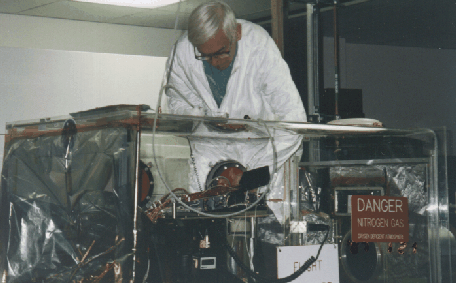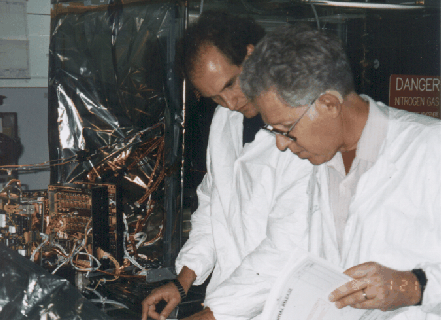

Preparing the Mars Global Surveyor TES. Engineers Steve Silverman (left) and Rolph Keehn check the latest data at SBRC. The TES instrument that will go to Mars is being assembled in the plastic case behind them. Photo by P. Christensen, November 1, 1995.
by Tricia Dieck, College of Education, ASU
In September I began working at the Mars Global Surveyor (MGS) Thermal Emission Spectrometer (TES) facility at Arizona State University (ASU) as an education outreach assistant. I am a graduate student working toward a master's degree in elementary education with an emphasis in science. I taught sixth grade science for two years in Milwaukee, Wisconsin, and sixth and seventh grade science for two years in St. Paul, Minnesota. With the MGS TES project, I give tours of the ASU TES facility, assist with teacher workshops and classroom visits, and work on developing new ways to inform K-12 teachers and students about our exciting program.
When I first began working here, my main focus was simply to learn about Mars, Mars missions, and the MGS TES. My knowledge increased, but there were still many questions I had. The director of the Mars K-12 Education Program, Ken Edgett, suggested that I should go talk to the engineers that are building the TES at the Hughes, Santa Barbara Research Center (SBRC) in Goleta, California. My trip was on November 1, 1995.
I was scheduled to take an early morning flight with Phil Christensen (TES Principal Investigator and ASU Professor of Geology) to Santa Barbara. I would be returning the same evening. I was quite anxious about the trip. I had never really had the opportunity to talk at length with Phil, and here I would be talking with him and other scientists and engineers, people with advanced science degrees, about some pretty heavy science topics. I was slightly intimidated, to say the least.
Upon arrival at SBRC, we received our security badges and waited to be escorted into the TES lab. The room resembled a hospital environment, only not as sterile, with areas partitioned off by curtains. Phil introduced me to several engineers as I was trying to peer around a curtain to catch a glimpse of the TES. They finally caught on to my anticipation and took me to see the TES.

SBRC engineer Tom Tourville adjusts the TES optics during Tricia's visit. The TES is inside the plexiglass box to protect it from moisture and dust. Photo by P. Christensen, November 1995.
While I was there, the engineers were working on adjusting the optics of TES. TES has about ten to fifteen mirrors which allow the infrared light to travel through the instrument. Proper alignment of the mirrors is needed to get accurate measurements of the infrared spectra. The room was dark because the engineers were testing the field of view of the TES, and outside light could throw off the results. The engineers have been working on fine-tuning the mirrors for about six months.
Phil took me around the SBRC campus to meet others who were working on the project and to see other facilities. There was a large "Clean Room" where SBRC is building other spacecraft and instruments. This room is very sterile. All instruments are covered with blankets when not being used, to prevent excessive exposure.
Phil also showed me the area where circuit boards were assembled. Technicians work using microscopes to see and assemble the boards. TES has 10 circuit boards. I was shown the books (more than 80!) that are used to track the parts for the TES. There are thirty-eight pages of parts just for one TES circuit board! In another room, there are thermal chambers to test instruments after they are assembled. The TES will spend about two weeks in one of these chambers, being tested in a vacuum and under extreme temperature conditions. In an adjacent room, there was a new, huge thermal chamber that will be used to test the MODIS (Moderate Resolution Imaging Spectroradiometer which will launch aboard the Earth Observing System in 1998). It was a chamber that was about 10 feet in diameter. This chamber took up the whole room!
When we returned from our tour, the TES engineers were celebrating. The TES mirrors had been aligned! Phil looked at the data and confirmed that it was accurate. The mirrors would then be secured in their current positions. This was a major milestone!
The next phase of TES assembly will be to package up the electronics. When I was there, the electronic circuit boards were all laid out, in a fan pattern, on the table next to the chamber containing the TES. The next major milestones will be testing the TES. TES will be subjected to extreme temperatures and put on a "shaking" table to ensure that all the parts won't come loose when TES is launched. These tests will take place between January and March of 1996. After testing, TES will be flown by airplane to Denver, Colorado, where it will be bolted to the MGS spacecraft. Mars Global Surveyor will launch in November 1996, with TES onboard.
For more information about Tricia's trip to SBRC, see future issues of TES News. Tricia will introduce you to some of the people who helped make the TES, and give some of the basics on how it works. -- Editor.